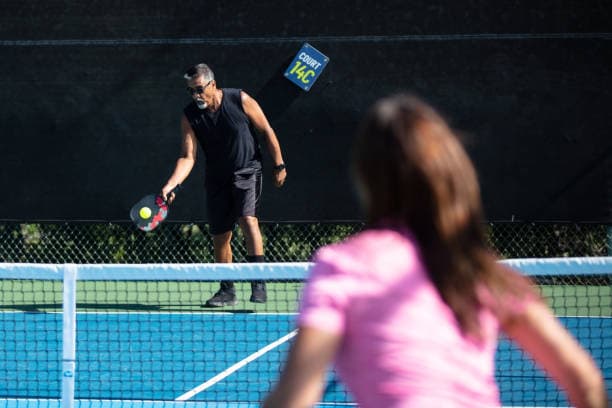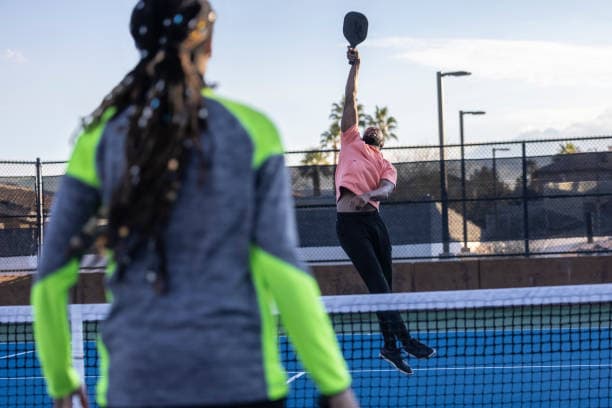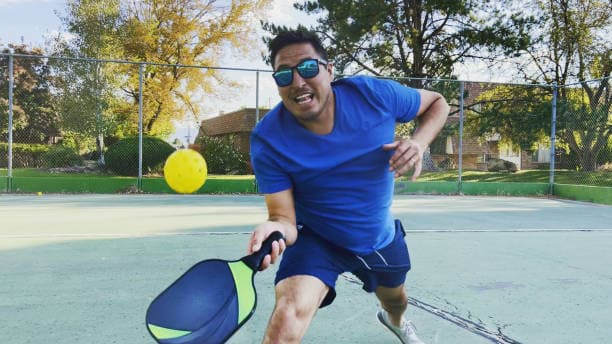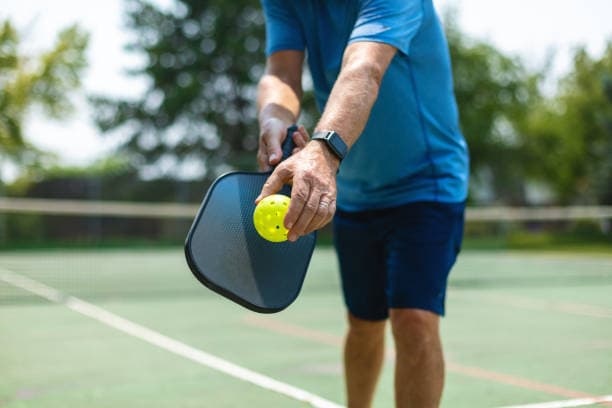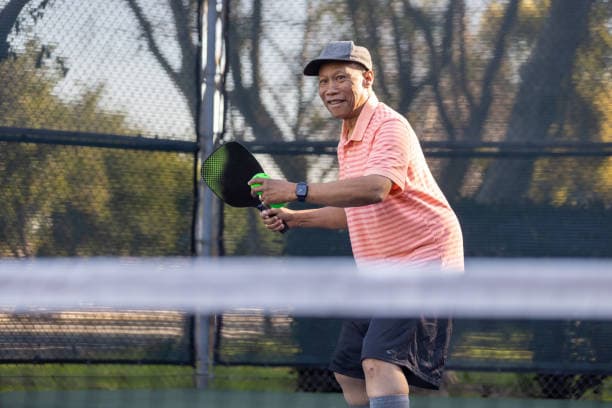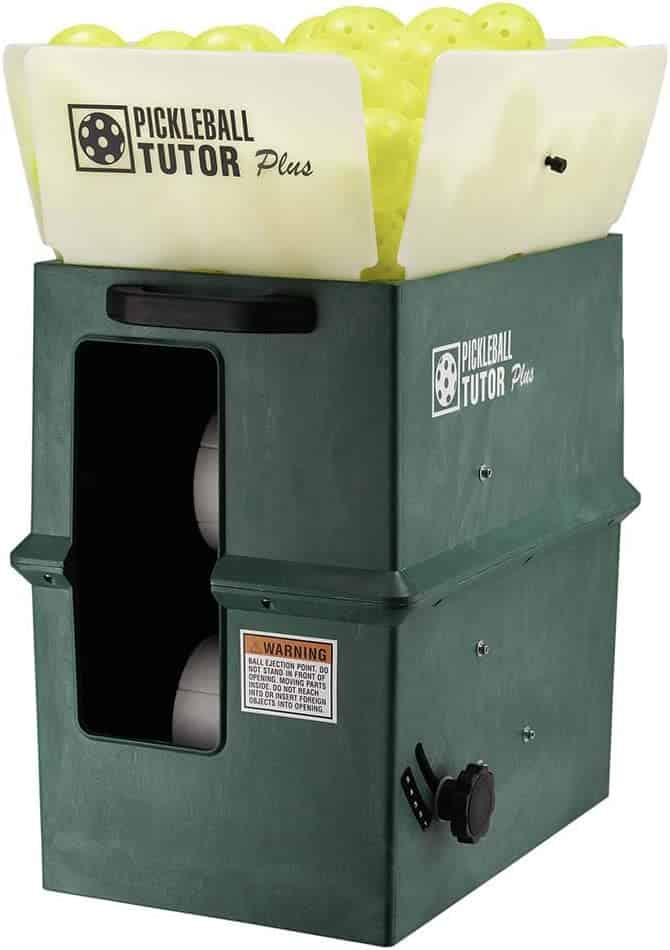Pickleball Lob Shot
Within this rapidly growing community of players, mastering the art of the pickleball lob shot is considered a crucial skill that can elevate your game to new heights. The lob is a strategic stroke that involves hitting the ball high into the air, causing it to arc over the net and land deep in your opponent’s court.
What is a Lob shot?
The pickleball lob shot is an essential technique used to create distance between you and your opponents during a rally. It requires precision and finesse as you aim to lift the ball high above their reach while maintaining control over its trajectory. The objective is for the lobbed ball to land deep in your opponent’s court, making it difficult for them to execute an aggressive shot in response.
Importance and Benefits of Mastering the Pickleball Lob
Mastering the art of the lob brings significant advantages on both offensive and defensive fronts. One key benefit is creating opportunities for offensive plays by putting pressure on your opponents’ positioning and forcing them back toward their baseline. This opens up space at the front of their court for you to exploit with powerful groundstrokes or well-placed drop shots.
Incorporating effective lobs into your game can neutralize aggressive opponents who rely heavily on strong smashes or volleys close to the net. By employing well-executed lobs strategically throughout points, you can disrupt their rhythm, force them out of their comfort zone near the net, and introduce more unpredictability into rallies.
Understanding the Basics
Explanation of the Lob Shot Technique
The pickleball lob can be an effective offensive weapon or a defensive strategy, depending on the situation. To execute a successful lob shot, players must utilize proper technique and timing. The key is to generate enough height and distance to make it challenging for your opponent to return the ball.
The lob shot begins with a controlled backswing where you bring your paddle back behind you while maintaining a relaxed grip. As you swing forward make contact with the ball slightly above its center using an open paddle face.
This upward contact will create topspin on the ball that helps it soar high and dip steeply towards your target area on the court. The follow-through should be smooth and fluid, ensuring that you maintain control and balance throughout the shot.
Key Factors to Consider Before Attempting a Lob
Before attempting a pickleball lob shot, there are several crucial factors that players must keep in mind. First and foremost is court positioning and footwork.
Proper positioning determines your ability to spot opportunities for lobs and execute them effectively. When considering whether to attempt a lob, analyze your opponent’s position on the court – if they are too close to the net or out of position towards one side of their half-court, it may be an opportune moment for a well-placed lob.
Another significant factor is grip and paddle angle. Your grip should allow for control while still generating enough power for an effective lob shot. Experiment with variations such as continental grip or eastern backhand grip based on your level of comfort and desired results.
Additionally, paddle angle plays a vital role in determining how high or low your lob will travel over the net. A more open paddle face will generate more height, while a slightly closed face will produce a flatter trajectory. It is essential to practice and experiment with different grips and paddle angles to find what works best for your game style and the specific lob shot situation you encounter on the court.
Grip Variations for Different Types of Lobs (Forehand/Backhand)
When it comes to hitting successful lobs in pickleball, understanding the importance of grip variations is paramount. Whether you’re executing a forehand or backhand lob, the proper grip can significantly impact your shot’s accuracy and control. For forehand lobs, using a semi-western grip allows for greater wrist flexibility and easier paddle maneuverability.
This grip enables you to generate more topspin which provides better control over the trajectory and landing spot of your lob shot. On the other hand, when hitting a backhand lob, using an Eastern backhand grip is advisable.
This grip provides stability and good paddle control during your swing motion. By positioning your hand lower on the handle with your thumb resting along the backside of the paddle you’ll gain leverage while maintaining stability throughout the execution.
Breakdown of Lob Shot Execution
Preparation: Positioning and Anticipation
The first step towards successfully executing a lob shot is positioning yourself correctly on the court. Anticipate your opponent’s shot early by reading their body language and paddle position. Move swiftly towards an ideal location that allows you to comfortably reach their incoming shot without feeling rushed or off balance.
As you approach this position maintain slightly bent knees for quick movement in any direction. Distribute your body weight evenly between both feet to ensure stability during rapid changes in direction while maintaining agility.
Backswing: Paddle Positioning and Body Rotation
In preparation for your lob’s backswing phase, position your paddle at hip level with both hands firmly gripping it according to the appropriate variation mentioned earlier (forehand or backhand). By keeping the paddle face open you create an optimal angle for generating upward lift and accurate trajectory.
During the backswing, engage your core muscles to rotate your upper body and shoulders in a coordinated manner. This rotational movement generates increased power and range of motion for the subsequent shot that allows you to execute a stronger lob with greater control.
Contact Point: Timing, Height, and Paddle Face Angle
The contact point is crucial in determining the success of your lob. Timing is key here – aim to make contact with the ball at its highest point during its upward trajectory.
This timing ensures that you generate maximum height and distance for your shot. Pay close attention to paddle face angle adjustment.
Slightly angling the paddle face backward or forward can significantly impact both spin generation and shot accuracy. Experiment with these adjustments during practice sessions to find what works best for you in different game situations.
Follow Through: Balance and Control
The final phase of a successful lob shot execution is maintaining balance and control throughout your follow-through. Once you make contact with the ball continue your swing smoothly while maintaining proper weight distribution on both feet.
Avoid excessive swinging or abruptly stopping after making contact; instead, allow your arm to extend fully as part of a fluid motion that aids control over directionality and smooth placement of your lob. By emphasizing follow-through with balance and control, you ensure that the energy generated from your swing transfers efficiently into an accurate lob while also setting yourself up quickly for your next shot.
Advanced Lob Shot Strategies
Using Spin Variations to Enhance Your Lobs' Effectiveness
When it comes to hitting a successful lob shot in pickleball, incorporating spin variations can significantly elevate your game. One such technique is the topspin lob, which involves imparting forward spin on the ball to create a high arc and make it difficult for your opponent to attack. Topspin lobs are particularly useful when you want to disrupt your opponent’s rhythm or force them out of their comfort zone.The topspin adds an element of unpredictability that makes it challenging for them to accurately time their return.
To execute a topspin lob successfully, focus on brushing the ball with an upward motion at contact and ensure your paddle face is slightly open. This will generate the necessary lift and spin required for a well-placed topspin lob. On the other hand, backspin lobs are equally valuable in certain situations.
Using backspin allows you to control the trajectory of the ball more precisely and increase its descent speed upon landing. Backspin lobs are particularly handy when you need to create defensive opportunities or prevent aggressive opponents from approaching the net confidently. To execute a backspin lob effectively, brush down on the ball at contact with a slightly closed paddle face. This imparts backward spin that causes the ball to dip swiftly after crossing over the net.
Tactical Considerations
The decision between offensive and defensive lobs should depend on various factors such as court positioning and your opponent’s skill level. Offensive lobs are usually employed when you have good court position and can take advantage of weak returns from opponents who struggle with high balls or lack mobility. In this scenario aim your lob shots closer towards the baseline rather than near the sidelines since it increases the margin for error and makes it harder for your opponent to attack.
As an offensive lobber, focus on using topspin lobs to disrupt your opponent’s rhythm, force them backward, and create opportunities for aggressive shots. On the other hand, defensive lobs are valuable when you find yourself out of position or under pressure from opponents who have a strong net game.
In these situations prioritize accuracy and placement over power. Stay in the point. Aim your backspin lobs towards the sidelines to force your opponents to cover a larger area and make it more challenging for them to execute effective shots. Defensive lobbers should also focus on height and depth over speed, giving themselves time to recover their position while minimizing their opponent’s offensive options. It’s important to assess your opponent’s skill level before deciding on offensive or defensive lob strategies.
Against aggressive players who excel at smashing overheads, defensive lobs may be more effective in neutralizing their power game. Against opponents who struggle with mobility or have difficulty handling high shots, opting for offensive lobs can put them under significant pressure.
Remember that these strategic considerations should always be adapted based on the specific situation during a match. Being aware of court positioning, analyzing your opponent’s strengths and weaknesses, and adjusting accordingly will enable you to make well-informed choices regarding what kind of lob you should hit.
Pro Tips from Pickleball Legends
Simone Jardim's Unpredictable and Disguised Lobs
When it comes to hitting successful lob shots, Simone Jardim, a renowned figure in the pickleball world, emphasizes the importance of disguise and unpredictability. She believes that keeping her opponents guessing is key to gaining an advantage on the court.
One strategy she employs is altering the timing of her lob shots. Instead of consistently hitting lobs at the same moment in a rally, Jardim mixes up her timing, making it harder for her opponents to anticipate and respond effectively.
Jardim pays great attention to body language and shot preparation. By maintaining a consistent motion and body posture while hitting various shots, she minimizes any visual cues that might give away her intention to hit a lob shot. This element of surprise keeps her opponents off balance and increases the likelihood of winning points through successful lobs. Furthermore, Jardim focuses on employing different shot techniques while executing lobs.
By varying spin and trajectory (such as hitting topspin or backspin lobs), she adds another layer of unpredictability to her shots. This technique not only makes it harder for opponents to read the ball but also increases their chances of making errors when attempting returns.
Kyle Yates Using Placement to Exploit Opponents' Weaknesses
Kyle Yates, another distinguished pickleball professional known for his strategic brilliance, adopts a different approach when it comes to hitting successful lob shots. He believes in utilizing strategic placement rather than pure power or height alone. Yates pays close attention to his opponents’ positioning on the court and exploits their weaknesses by directing his lobs precisely where they are least comfortable defending.
Yates often observes his opponents’ movement patterns during rallies before determining where he should deliver his lob shots. If he notices his opponents struggling with overhead shots or moving slower towards the backcourt, he capitalizes on these weaknesses by hitting deep and well-placed lobs. By doing so he forces his opponents into difficult positions and limits their options for effective returns.
Moreover, Yates believes in incorporating deception into his lob shots. He occasionally disguises a drop shot as a lob, catching his opponents off guard and forcing them to retreat quickly to the net. This sudden change of pace and direction often results in weak returns or even outright winners for Yates.
Overall, both Jardim and Yates provide valuable insights into hitting successful lob shots in competitive matches. Their emphasis on disguise, unpredictability, strategic placement, and taking advantage of opponents’ weaknesses can greatly influence your skills in hitting effective lobs on the pickleball court.
Common Mistakes & Troubleshooting Techniques
Identification of Common Errors While Attempting a Pickleball Lob
When attempting a pickleball lob shot several common mistakes can hinder your success. One prevalent error is misjudging the height of the ball. It’s essential to assess the trajectory accurately and anticipate its peak point to time your shot correctly. Failing to do so may result in mistimed contact and a poorly executed lob.
Another mistake is not adjusting the paddle face angle appropriately. Depending on whether you want to hit a topspin or backspin lob, the paddle angle needs to be adjusted accordingly to ensure that you generate enough spin for the ball’s trajectory.
Additionally, inadequate footwork and positioning can lead to ineffective lobs. If you’re off-balance or too close to the net while attempting a lob it will be challenging to execute it with precision and accuracy.
Lack of disguise can make your lobs predictable for your opponents. By telegraphing your intention too early or giving away subtle cues through body language or paddle position, you may give your opponents an advantage in anticipating and countering your lob shot.
Lastly, pay attention to which way the wind is blowing. If the wind is behind you, you may need to take a little bit of power off the lob and add more spin. If the wind is against you, add power.
Troubleshooting Techniques for Hitting Better Lobs
To troubleshoot these common errors and improve your pickleball lob shots, several techniques can be employed.
Practice judging ball height by developing better peripheral vision on the court. Regularly engage in drills that involve tracking high balls and work on estimating their apex accurately. This will enhance your ability to time your shots effectively.
Focus on mastering paddle face angle adjustments based on desired spin variations for different types of lobs. Spend time practicing hitting consistent topspin lobs by tilting the paddle slightly forward during contact with the ball while employing an upward brushing motion.
To improve footwork and positioning for successful lobs, concentrate on maintaining proper court coverage and positioning yourself optimally.
Be mindful of your distance from the net, keeping a slightly deeper position to allow enough space for executing a well-controlled lob.
Work on disguising your lob shots by employing deceptive body movements and paddle positioning.
Keep your opponents guessing by using similar stances and swings for both lobs and other shots.
Determine which side of the court has the sun in their eyes and when the sun is in your opponents eyes, use the lob frequently.
By incorporating these troubleshooting techniques into your training routine, you will gradually refine your pickleball lob shots and become a more formidable player on the court.
Conclusion
Mastering the art of hitting a pickleball lob shot requires patience, practice, and attention to detail. By understanding the fundamental technique, perfecting it through repetition, and implementing advanced strategies you can elevate your game to new heights. While common mistakes can hinder progress initially, identifying them and applying effective troubleshooting techniques will help you overcome these challenges.
With time and dedication to improvement you’ll find yourself executing successful lobs consistently while keeping your opponents off balance. So embrace the challenge of mastering this essential shot in pickleball.
Remember that every mistake is an opportunity to learn and grow as a player. With persistence and perseverance, you’ll soon be hitting breathtaking lobs that leave opponents in awe while gaining a valuable weapon in your arsenal of skills (soon people will be asking you to teach them how to hit a lob!).

